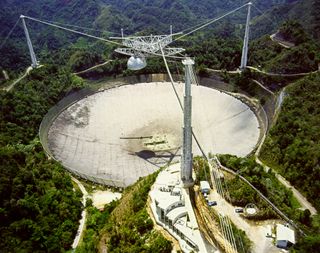Puerto Rico's Arecibo Observatory Will Stay Open, Despite Funding Concerns

Two months since Hurricane Maria wreaked havoc on Puerto Rico, most of the island is still recovering from the disaster — including the Arecibo Observatory, home of the world's second-largest radio telescope. This week, the dozens of astronomers and other staff at the facility have some good news to celebrate: The Arecibo Observatory will remain open after years of being on the chopping block.
The National Science Foundation (NSF), which funds approximately two-thirds of the observatory's annual budget of $12 million, announced on Thursday (Nov. 16) that it will not shut down the Arecibo Observatory. This decision comes after more than a decade of discussions about the future of the 54-year-old observatory.
However, this good news comes with one drawback: The NSF still plans to withdraw much of the funding it gives to the observatory, reducing its annual contribution from $8.2 million to $2 million over the next five years, the journal Nature reports. But instead of leaving the observatory high and dry, the NSF is working to secure new partnerships with other institutions that can take over the burden of funding and managing the facility. [Arecibo Observatory: Puerto Rico's Giant Radio Telescope in Photos]
"This is very good news for the Arecibo Observatory and a huge win for the scientific community in general," Francisco Córdova, the observatory's director, told Nature. "There is definitely a sense of relief in the air."
The announcement brought a much-needed sigh of relief to the people who operate the observatory as well as many other members of the local community who found shelter and solace at the facility after losing their homes in Hurricane Maria.
While the Arecibo Observatory fared pretty well during hurricane compared to much of the rest of the island, it did sustain some minor damages. With the NSF already working on plans to reduce funding and potentially close the observatory, costly damages could have been the last straw. However, the damage turned out to be minimal. The NSF estimates that repairs should cost somewhere between $4 million and $8 million.
"NSF remains deeply concerned about the impacts from recent hurricanes on Arecibo Observatory staff, the facility and all citizens of Puerto Rico," NSF officials said in a statement, adding that the decision "arrives at a challenging time, but is necessary for the agency to secure a future for the observatory. It will allow negotiations to begin with potential collaborators who may take over management and operations as NSF funding for the observatory is reduced.
Get the Space.com Newsletter
Breaking space news, the latest updates on rocket launches, skywatching events and more!
"We were quite surprised by how little damage there was," John Kelly, an investigator with SRI International, which helps to operate the observatory, told Space.com. "The reflector itself sustained minor damage when a couple of minor feed antennas broke and fell into the dish, damaging 15 or 20 of the panels. There are thousands of panels that make up that reflector, and only about 15 or 20 have been damaged. And they're replaceable … I don't think the damage is anywhere near what would be considered a justifiable reason for decommissioning the facility at this point," Kelly said.
In addition to the NSF, SRI International and other research institutions, the Arecibo Observatory also receives funding from NASA to look for near-Earth asteroids that could pose a danger to the planet. Astronomers also use the facility to look for potentially habitable exoplanets and signs of extraterrestrial intelligence.
Email Hanneke Weitering at hweitering@space.com or follow her @hannekescience. Follow us @Spacedotcom, Facebook and Google+. Original article on Space.com.
Join our Space Forums to keep talking space on the latest missions, night sky and more! And if you have a news tip, correction or comment, let us know at: community@space.com.

Hanneke Weitering is a multimedia journalist in the Pacific Northwest reporting on the future of aviation at FutureFlight.aero and Aviation International News and was previously the Editor for Spaceflight and Astronomy news here at Space.com. As an editor with over 10 years of experience in science journalism she has previously written for Scholastic Classroom Magazines, MedPage Today and The Joint Institute for Computational Sciences at Oak Ridge National Laboratory. After studying physics at the University of Tennessee in her hometown of Knoxville, she earned her graduate degree in Science, Health and Environmental Reporting (SHERP) from New York University. Hanneke joined the Space.com team in 2016 as a staff writer and producer, covering topics including spaceflight and astronomy. She currently lives in Seattle, home of the Space Needle, with her cat and two snakes. In her spare time, Hanneke enjoys exploring the Rocky Mountains, basking in nature and looking for dark skies to gaze at the cosmos.
